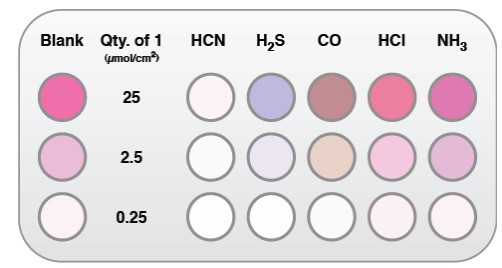Atmospheric pollutant gases are mainly released by industrial activities, vehicles, and combustion processes, representing a severe problem for air quality and human health, making it crucial to detect and monitor them to avoid large-scale problems. Nowadays, colorimetric sensors are a frequent option to detect pollutant gases, based on color changes produced by chemical reactions between gases and specific chemical reagents. However, traditional colorimetric sensors have some limitations that can cause problems in their operation, such as low sensitivity and not very specific and selective, affecting the accuracy of the measurements. In general, the current issue to detecting polluting atmospheric gases is the need to remove those barriers and develop more advanced and accurate sensing technologies to protect air quality and mitigate adverse effects on human health and the environment.
Researchers from the IDM have developed more selective, sensitive, and efficient colorimetric sensors to detect these pollutant gases, overcoming the limitations that previously affected this type of sensor.
The technology proposed consists of the development of electrochemical-molecular sensors, colorimetric and fluorometric sensors to recognize and detect chemical species of interest and detect analytes in the fields of environment, occupational safety, and civil safety. Signaling and receiving units are used for rapid, naked-eye detection. Sensors can be chromogenic, fluorogenic, or electrochemical, based on chemical compounds or materials that exhibit color changes and fluorescent light emission when interacting with target gases.
The chemical interaction between the gas and the sensing material causes changes in the electronic or chemical structure of the compound, resulting in observable changes in color and/or fluorescent light emission.

Tests have been conducted in the laboratory, and a prototype has been developed to validate the technology in a real environment.
Benefits:
- Warning systems that are accessible and easily interpretable.
- Detection of pollution with the naked eye without the need for any additional instrumentation.
- The sensors are easy to prepare and affordable.
- The sensors developed are selective in the presence of other gases, with low detection limits, allowing for higher sensitivity.
- Use of environmentally friendly compounds that do not endanger the environment in which they are used.
The represented institution is looking for a collaboration that leads to commercial exploitation of the presented invention.
Institution: Instituto Interuniversitario de Investigación de Reconocimiento Molecular y Desarrollo Tecnológico (IDM)
TRL: 4
Contact: Noelia Mas / noelia@viromii.com

